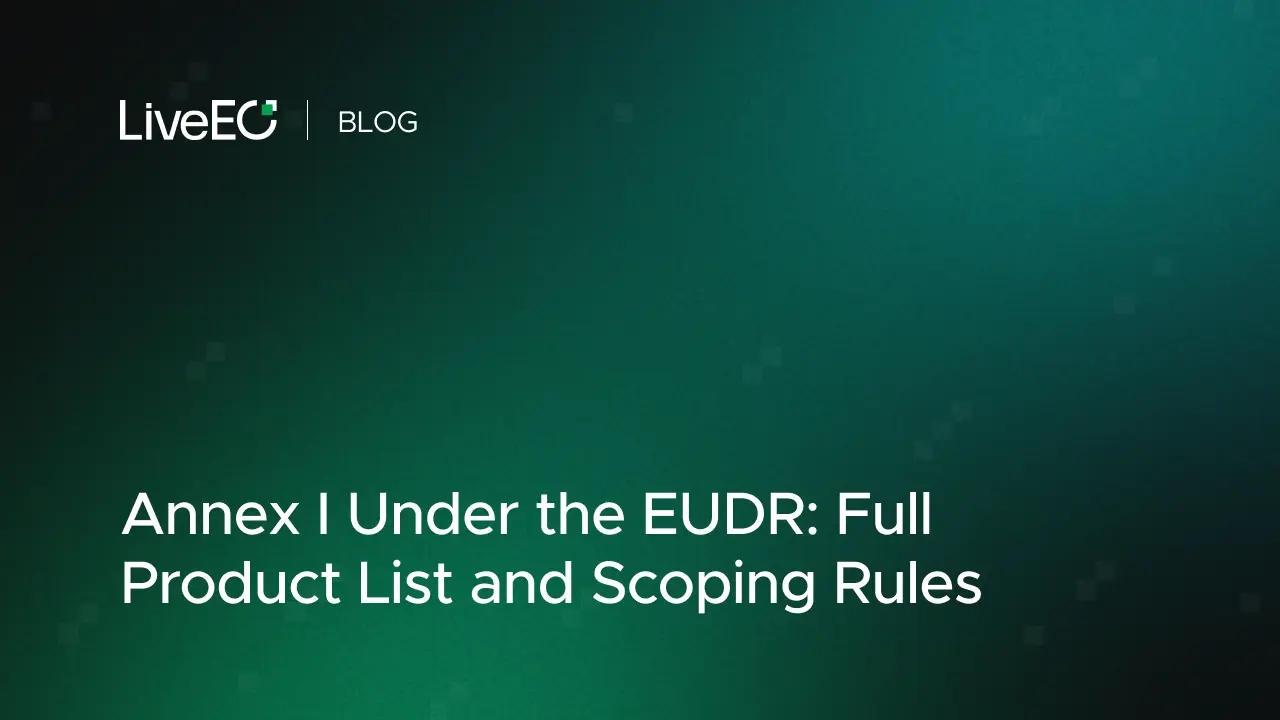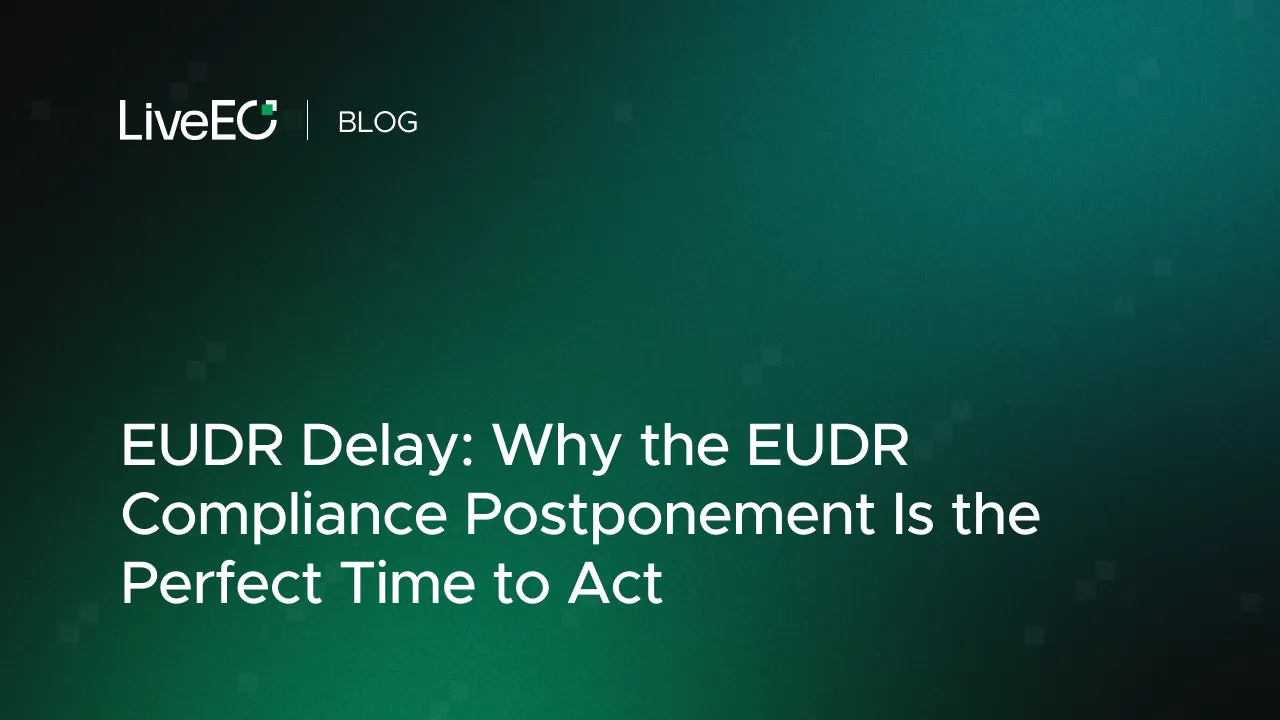This guide will help you determine whether your products fall within the scope of the EU Deforestation Regulation (EUDR). The regulation is designed to restrict access to the EU market for goods linked to deforestation and forest degradation.
Its goal is to prevent environmental harm, specifically deforestation, biodiversity loss, and climate change, by ensuring that only deforestation-free products enter the market.
Annex I of the regulation defines exactly which commodities and derived products are subject to these rules.
What Annex I Does: Defining Relevant Commodities and Products
Annex I lists the relevant commodities (cattle, cocoa, coffee, oil palm, rubber, soya, wood) and a long list of derived products, each identified by CN/HS codes. Together, they define which goods are in scope. If a product is not listed in Annex I, it is out of scope, even if it contains a relevant commodity (e.g., soap with palm oil is out).
Two clarifications built into Annex I matter for scoping:
- Waste/recycled material rule. If the good is made entirely from material that has completed its life cycle and would otherwise be discarded as waste, it is out of scope; by-products and goods that include any non-recycled content remain in scope for that non-recycled part.
- Packaging carve-out. Wood packaging is out when used exclusively to support/protect/carry another product, but in scope when placed on the market as a product in its own right.
Read also: 28 EUDR Definitions You Need to Know
Reading Annex I for Product Classification
Annex I entries rely on CN/HS codes and product descriptions to define what’s in scope.
To avoid errors, it's crucial to understand how to interpret the listed codes and any accompanying qualifiers.
Read the “ex” Before Some HS Codes Correctly
In the document, you’ll see entries like “ex 0201” or “ex 9401.” The “ex” means Annex I only captures the subset described in the right-hand column, not everything that can sit under that HS code.
Example: HS 0201 (“meat of bovine animals”) becomes ex 0201 = “meat of cattle” (genus Bos etc.), but not bison or buffalo.
Similarly ex 9401 narrows seats to wooden seats only.
Practical implication: to be in scope, a product must (a) fall under the cited tariff line and (b) match the Annex I description for the relevant commodity in the left column.
Classify Once, Classify Right
The EUDR uses the EU Combined Nomenclature (CN); CN builds on the global 6-digit HS and is updated annually.
For imports, CN can further split to TARIC (10 digits). Your scoping should follow the digit level in Annex I.
Reporting obligations require operators to submit due diligence statements for all relevant products, and these diligence statements are essential for compliance.
When you submit a DDS, you must include the HS code and quantity (net mass for import/export) exactly as Annex II requires.
A due diligence statement (also referred to as a diligence statement) must be submitted through the EU's information system, Traces NT.
Practical Scoping Workflow for EUDR Compliance using Annex I
To help you act quickly, this section offers a step-by-step workflow for assessing which of your products are in scope.
Following these steps will streamline your EUDR scoping process and prepare your business for due diligence reporting.
- Pull your product master. Map each SKU to a CN/HS code and check for Annex I matches (remember the “ex” narrowing).
- Apply the three carve-outs early: (i) not in Annex I → out; (ii) entirely recycled/waste → out; (iii) packaging used exclusively as packaging → out. Document each call.
- Flag composites. For likely in-scope composites, list each relevant component.
- Decide the role per transaction. Are you acting as operator (placing/exporting) or trader? Non-SME traders have operator-like duties for the products they make available. SMEs may rely on upstream DDS in defined cases but still carry responsibility for compliance.
Annex I: Edge Cases To Watch
Some scenarios require extra attention to avoid compliance oversights. The following edge cases often lead to confusion and should be double-checked in your due diligence process.
- Upstream/outside-EU processing & re-imports. Products made abroad from EU-placed relevant products can re-enter using upstream DDS references; parts not previously covered must undergo due diligence.
- “Same CN, different commodity.” Only products made of the relevant commodity are in scope (e.g., natural rubber vs. synthetic rubber under similar headings).
Reporting obligations for SMEs and non-SMEs may differ, but diligence statements are required for all in-scope products.
Quick Annex I Exposure Checklist
Use this checklist to validate your scoping decisions and identify any last gaps in your EUDR compliance process.
It covers the essential factors to confirm whether a product is in or out of scope under Annex I.
- Is the product’s CN/HS code listed in Annex I? If “ex”, does it match the narrow description? → In / Out.
- Is it entirely recycled/waste? If yes → Out. If not, the non-recycled part is in scope.
- If a composite, do you have all geolocations or reliable upstream DDS references for each relevant component?
- For imports/exports, will your customs declaration include the DDS reference number(s)?
Read also: EUDR FAQ Update 2024: Everything You Need to Know
Annex I Text: Full Product List
The following list is a direct excerpt from Annex I of the EUDR regulation. It includes all currently regulated commodities and derived products, specified by CN/HS codes. Refer to this list to determine whether a product falls within the regulation's scope.
Important note: The EU Commission may amend Annex I via delegated acts and must review scope, including additional commodities, on a set timetable. So the following list might change over time. LiveEO customers will be informed about any changes to Annex I.
Cattle
0102 21, 0102 29 Live cattle
ex 0201 Meat of cattle, fresh or chilled
ex 0202 Meat of cattle, frozen
ex 0206 10 Edible offal of cattle, fresh or chilled
ex 0206 22 Edible cattle livers, frozen
ex 0206 29 Edible cattle offal (excluding tongues and livers), frozen
ex 1602 50 Other prepared or preserved meat, meat offal, blood, of cattle
ex 4101 Raw hides and skins of cattle (fresh, or salted, dried, limed, pickled or otherwise preserved, but not tanned, parchment-dressed or further prepared), whether or not dehaired or split
ex 4104 Tanned or crust hides and skins of cattle, without hair on, whether or not split, but not further prepared
ex 4107 Leather of cattle, further prepared after tanning or crusting, including parchment-dressed leather, without hair on, whether or not split, other than leather of heading 4114
Cocoa
1801 Cocoa beans, whole or broken, raw or roasted
1802 Cocoa shells, husks, skins and other cocoa waste
1803 Cocoa paste, whether or not defatted
1804 Cocoa butter, fat and oil
1805 Cocoa powder, not containing added sugar or other sweetening matter
1806 Chocolate and other food preparations containing cocoa
Coffee
0901 Coffee, whether or not roasted or decaffeinated; coffee husks and skins; coffee
substitutes containing coffee in any proportion
Oil Palm
1207 10 Palm nuts and kernels
1511 Palm oil and its fractions, whether or not refined, but not chemically modified
1513 21 Crude palm kernel and babassu oil and fractions thereof, whether or not refined,
but not chemically modified
1513 29 Palm kernel and babassu oil and their fractions, whether or not refined, but not
chemically modified (excluding crude oil)
2306 60 Oilcake and other solid residues of palm nuts or kernels, whether or not ground or
in the form of pellets, resulting from the extraction of palm nut or kernel fats or oils
ex 2905 45 Glycerol, with a purity of 95 % or more (calculated on the weight of the dry
product)
2915 70 Palmitic acid, stearic acid, their salts and esters
2915 90 Saturated acyclic monocarboxylic acids, their anhydrides, halides, peroxides and
peroxyacids; their halogenated, sulphonated, nitrated or nitrosated derivatives (excluding
formic acid, acetic acid, mono-, di- or trichloroacetic acids, propionic acid, butanoic acids,
pentanoic acids, palmitic acid, stearic acid, their salts and esters, and acetic anhydride)
3823 11 Stearic acid, industrial
3823 12 Oleic acid, industrial
3823 19 Industrial monocarboxylic fatty acids; acid oils from refining (excluding stearic acid,
oleic acid and tall oil fatty acids)
3823 70 Industrial fatty alcohols
Rubber
4001 Natural rubber, balata, gutta-percha, guayule, chicle and similar natural gums, in
primary forms or in plates, sheets or strip
ex 4005 Compounded rubber, unvulcanised, in primary forms or in plates, sheets or strip
ex 4006 Unvulcanised rubber in other forms (e.g. rods, tubes and profile shapes) and articles
(e.g. discs and rings)
ex 4007 Vulcanised rubber thread and cord
ex 4008 Plates, sheets, strips, rods and profile shapes, of vulcanised rubber other than hard
rubber
ex 4010 Conveyer or transmission belts or belting, of vulcanised rubber
ex 4011 New pneumatic tyres, of rubber
ex 4012 Retreaded or used pneumatic tyres of rubber; solid or cushion tyres, tyre treads and
tyre flaps, of rubber
ex 4013 Inner tubes, of rubber
ex 4015 Articles of apparel and clothing accessories (including gloves, mittens and mitts), for
all purposes, of vulcanised rubber other than hard rubber
ex 4016 Other articles of vulcanised rubber other than hard rubber, not elsewhere specified
in chapter 40
ex 4017 Hard rubber (e.g. ebonite) in all forms including waste and scrap; articles of hard
rubber
Soya
1201 Soya beans, whether or not broken
1208 10 Soya bean flour and meal
1507 Soya-bean oil and its fractions, whether or not refined, but not chemically modified
2304 Oilcake and other solid residues, whether or not ground or in the form of pellets,
resulting from the extraction of soya-bean oil
Wood
4401 Fuel wood, in logs, in billets, in twigs, in faggots or in similar forms; wood in chips or
particles; sawdust and wood waste and scrap, whether or not agglomerated in logs,
briquettes, pellets or similar forms
4402 Wood charcoal (including shell or nut charcoal), whether or not agglomerated
4403 Wood in the rough, whether or not stripped of bark or sapwood, or roughly squared
4404 Hoopwood; split poles; piles, pickets and stakes of wood, pointed but not sawn
lengthwise; wooden sticks, roughly trimmed but not turned, bent or otherwise worked,
suitable for the manufacture of walking sticks, umbrellas, tool handles or the like;
chipwood and the like
4405 Wood wool; wood flour
4406 Railway or tramway sleepers (cross-ties) of wood
4407 Wood sawn or chipped lengthwise, sliced or peeled, whether or not planed, sanded or
end-jointed, of a thickness exceeding 6 mm
4408 Sheets for veneering (including those obtained by slicing laminated wood), for plywood
or for other similar laminated wood and other wood, sawn lengthwise, sliced or peeled,
whether or not planed, sanded, spliced or end-jointed, of a thickness not exceeding 6 mm
4409 Wood (including strips and friezes for parquet flooring, not assembled) continuously
shaped (tongued, grooved, rebated, chamfered, V-jointed, beaded, moulded, rounded or the
like) along any of its edges, ends or faces, whether or not planed, sanded or end-jointed
4410 Particle board, oriented strand board (OSB) and similar board (for example, waferboard)
of wood or other ligneous materials, whether or not agglomerated with resins or other
organic binding substances
4411 Fibreboard of wood or other ligneous materials, whether or not bonded with resins or
other organic substances
4412 Plywood, veneered panels and similar laminated wood
4413 Densified wood, in blocks, plates, strips or profile shapes
4414 Wooden frames for paintings, photographs, mirrors or similar objects
4415 Packing cases, boxes, crates, drums and similar packings, of wood; cable-drums of
wood; pallets, box pallets and other load boards, of wood;
pallet collars of wood
(not including packing material used exclusively as packing material to support, protect or
carry another product placed on the market)
4416 Casks, barrels, vats, tubs and other coopers’ products and parts thereof, of wood,
including staves
4417 Tools, tool bodies, tool handles, broom or brush bodies and handles, of wood; boot or
shoe lasts and trees, of wood
4418 Builders’ joinery and carpentry of wood, including cellular wood panels, assembled
flooring panels, shingles and shakes
4419 Tableware and kitchenware, of wood
4420 Wood marquetry and inlaid wood; caskets and cases for jewellery or cutlery, and
similar articles, of wood; statuettes and other ornaments, of wood; wooden articles of
furniture not falling in Chapter 94
4421 Other articles of wood
Pulp and paper of Chapters 47 and 48 of the Combined Nomenclature, with the exception of
bamboo-based and recovered (waste and scrap) products
ex 49 Printed books, newspapers, pictures and other products of the printing industry,
manuscripts, typescripts and plans, of paper
ex 9401 Seats (other than those of heading 9402), whether or not convertible into beds, and
parts thereof, of wood
9403 30, 9403 40, 9403 50, 9403 60 and 9403 91 Wooden furniture, and parts thereof
9406 10 Prefabricated buildings of wood
"{{inline}}"
FAQ: Understanding EUDR Annex I
What is Annex I of the EUDR?
Annex I is the official list of commodities and derived products that fall under the scope of the EU Deforestation Regulation (EUDR). If a product is not listed here, it is out of scope.
Which commodities are covered in Annex I?
The regulation applies to certain commodities: cattle, cocoa, coffee, oil palm, rubber, soya, and wood, along with many of their derived products, identified by specific CN/HS codes.
What does “ex” mean before some HS codes?
“Ex” indicates that only part of the HS code category is covered. For example, “ex 0201” includes “meat of cattle” but not bison or buffalo.
Are recycled materials in scope?
No. If a product is made entirely from recycled or waste material, it is out of scope. However, if it contains any non-recycled components, those parts remain in scope.
How does packaging affect Annex I classification?
Wood packaging is excluded if it is used solely to protect or carry another product. It is in scope only when marketed as a standalone product.
What if my product is a composite?
Each relevant component must be traced and included in due diligence if it contains a commodity from Annex I. Composites require detailed scoping and documentation.
What’s the practical step-by-step for checking compliance?
Start by mapping each product SKU to a CN/HS code. Then apply the three carve-outs, flag composites, and determine your role (operator or trader) to assess reporting duties.
What is required in a due diligence statement (DDS)?
The DDS must include the product's CN/HS code, net mass, and relevant traceability and risk assessment details. It must be submitted via the TRACES system.






